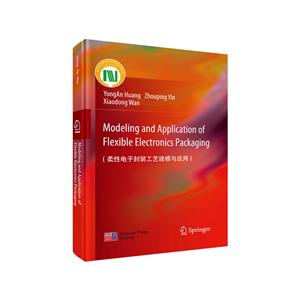Contents
Abbreviations
1 Advanced Electronic Packaging 1
1.1 Introduction 1
1.2 Adhesively Bonded Multilayer Structure 5
1.3 Interfacial Peeling-off 6
1.3.1 Needle Ejecting for Thin Chips 6
1.3.2 Conformal Peeling for Large-Area Devices 8
1.3.3 LLO for Large-Area Flexible Electronics 9
1.4 Vacuum-Based Chip Picking-up 12
1.5 Vacuum-Based Chip Placing-on 13
1.6 Competing Fracture 16
1.6.1 Competing Fracture Behavior 16
1.6.2 Fracture Strength and Adhesive Fracture Energy 16
References 17
2 Interfacial Modeling of Flexible Multilayer Structures 29
2.1 Introduction 29
2.2 Modeling of Chip-on-Substrate Structure 29
2.2.1 Mechanical Model 29
2.2.2 Analytical Evaluation on ERR of Interfacial Peeling 31
2.2.3 Virtual Crack Closure Technique (VCCT) 33
2.2.4 Numerical Model 34
2.3 Modeling of Chip-Adhesive-Substrate Adhesively Bonded Joints 34
2.3.1 Adhesive Model on Overlapped Joints 34
2.3.2 Equilibrium Equations 36
2.3.3 Establishment of Differential Equation Set 38
2.3.4 Solutions for Internal Forces and Displacements 40
2.3.5 Relationships Among Integration Constants 44
2.3.6 Theoretical Calculation of ERR of Interfacial Peeling 46
2.4 Summary 46
References 47
3 Measurement of Fracture Strength of Ultra-Thin Silicon Chip and Adhesive Fracture Energy 49
3.1 Introduction 49
3.2 Fracture Strength of Ultra-Thin Silicon Chip 50
3.2.1 Experimental Procedure 50
3.2.2 Nonlinear Mechanical Characterization in Bending Test 51
3.2.3 Estimation of Fracture Strength 58
3.3 Estimation of Adhesive Fracture Energy of Adhesive Tape 62
3.3.1 Theoretical Foundation 62
3.3.2 Experimental Procedure 64
3.3.3 Estimation of Adhesive Fracture Energy 64
3.3.4 Angle Dependence of Peel Force 65
3.3.5 Rate Dependence of Adhesive Fracture Energy 67
3.4 Summary 69
References 70
4 Tension-Assisted Peeling 73
4.1 Introduction 73
4.2 Theoretical Determination of Integration Constants 73
4.2.1 Stiffened Plate Joint Under Axial Tension and Bending Moment 74
4.2.2 Single-Strap Joint Under Tension 76
4.2.3 Single-Lap Joint Under Tension 79
4.3 Modeling of Adhesively Bonded Chip Array 82
4.3.1 Mechanical Model Description 82
4.3.2 Boundary and Continuity Conditions 84
4.3.3 Solution for Internal Forces and Displacements 85
4.3.4 Determination of Integration Constants 86
4.4 Adhesive Stresses for Adhesively Bonded Joints 87
4.4.1 Analysis of Balanced Adhesively Bonded Joints 87
4.4.2 Analysis of Unbalanced Adhesively Bonded Joints 90
4.4.3 Discussion of Results 92
4.5 Peeling Behavior for Chip Array on Stretched Substrate 93
4.5.1 Adhesive Stresses 93
4.5.2 Effect of Geometric Dimensions 95
4.5.3 Effect of Material Properties 98
4.5.4 Process Optimization 100
4.6 Summary 101
References 102
5 Single-Needle Peeling 105
5.1 Introduction 105
5.2 A Case for Chip-on-Substrate Structure 107
5.2.1 EfiFect of Crack Length 108
5.2.2 Effect of Geometric Dimensions 108
5.2.3 Effect of Elastic Mismatch 110
5.3 A Case for Chip-Adhesive-Substrate Structure 111
5.3.1 Geometric Model Description 111
5.3.2 Theoretical Calculation of ERR 115
5.33 Effect of Crack Length 116
5.3.4 Effect of Geometric Dimensions 117
5.3.5 Effect of Material Properties 118
5.3.6 Analysis on Tunability of Peeling Mode 119
5.4 Analysis of Fracture Mode Based on Competing Index 121
5.4.1 Typical Fracture Modes 121
5.4.2 Competing Fracture Model 123
5.4.3 Basic Fracture Parameters 124
5.4.4 Effect of Geometric Dimensions 125
5.4.5 Discussion on Results 127
5.5 Impact Effect of Needle Peeling-off Process 130
5.5.1 Failed Sample Observation 130
5.5.2 Numerical Model 130
5.5.3 Effect of Impact Speed 132
5.5.4 Effect of Substrate Penetration 134
5.6 Summary 135
References 137
6 Multi-Needle Peeling 139
6.1 Introduction 139
6.2 Mechanical Model of Multi-Needle Peeling-off 140
6.2.1 Model Description 140
6.2.2 Boundary and Continuity Conditions 142
6.2.3 Determination of Integration Constants 144
6.3 Competing Fracture Model of Chip-Adhesive-Substrate Structure 147
6.4 Analysis of Bending Normal Stress and ERR of Interfacial Peeling 151
6.4.1 Analysis of Bending Normal Stress 151
6.4.2 Analysis of ERR of Interfacial Peeling 154
6.5 Effect of Chip Geometry on Competing Fracture Behavior 156
6.5.1 Effect of Chip Thickness 156
6.5.2 Effect of Chip Length 158
6.6 Experimental Validation 160
6.7 Summary 162
References 163
Conformal Peeling 165
7.1 Introduction 165
7.2 Modeling of Conformal Peeling for Multilayer Structure 166
7.3 Effect of Material Properties and Geometric Size 174
7.3.1 Effect of Young's Modulus of Device Layer 174
7.3.2 Effect of Young's Modulus of Adhesive Layer 176
7.3.3 Effect of Device Thickness 179
7.3.4 Effect of Substrate Thickness 181


















